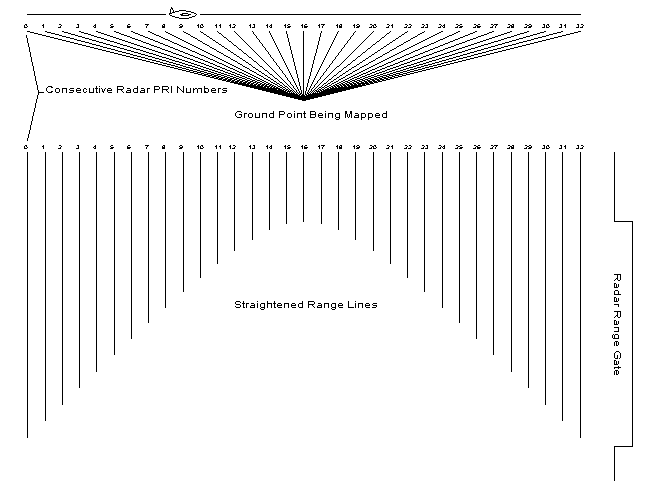Home Page or Table of Contents
The principles behind SAR processing are most easily visualized by looking at the so-called "brute force" approach to SAR image formation (other approaches involve using optical lenses or Fourier transforms). In this approach, each point or pixel on the image plane is formed by coherently summing the returns from each of a succession of returns along the flight path.

Each of the ranges from the airplane to the target has been rotated and aligned to illustrate the locus of points in range. This locus is a hyperbola (see section on SAR Geometry) and all of these points must fall within the range gate of the radar (shown on the far right side of the diagram). In order to form a coherent sum, each vector point (I,Q pair) must first be rotated from its geometrical position in the image field back to the transmitter (or to any other reference point). (For information on extending the Brute Force Method to more than one range bin, see SAR Processing (Brute Force, SAR Target Rotation).)
As an example, suppose we wish to form a single-point image using a beamwidth of 1000 successive looks (1000 radar PRIs) at a radar PRF of 200 PPI. The following single step is then necessary:
STEP 1 --Compute one range pixel by rotating and summing 1000 vectors along the appropriate range-azimuth hyperbola:
A + jB = (x1 + j y1) (cos1 + j sin1) + (x2 + j y2) (cos2 + j sin2) ... + (x1000+ j y1000) (cos1000 + j sin1000)
TOTAL OPERATIONS PER SECOND
(1 points) x (PRF of 200) x (8 operations per vector rotate) = 1.6 thousand operations/second
where an operation is either a multiply or add, independent of memory accesses.
For information on using interpolation to select points intermediate to those obtained from an evenly sampled data set, see Synthetic Aperture Radar (SAR) Processing Overview.
For information on extending the Brute Force Method to more than one range bin, see SAR Processing (Brute Force, Multiple Range Bins).